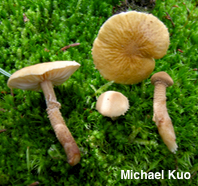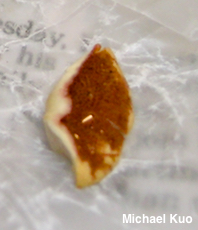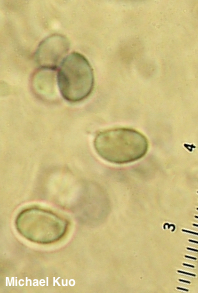| Major Groups > Gilled Mushrooms > Pale-Spored > Cystoderma & Cystodermella > Cystoderma amianthinum |

|
[Basidiomycota > Agaricales > Squamanitaceae > Cystoderma . . . ] Cystoderma amianthinum by Michael Kuo, 21 November 2025 Cystoderma amianthinum is an attractive species, found with some regularity in northern and montane (including Appalachian) regions of North America, usually growing in moss, under conifers. Distinguishing physical features include the yellowish cap, the dense coating of granules on the cap and stem, the fragile and ephemeral (rather than sturdy and persistent) ring; the usually pungent odor; and the reddish to reddish brown reaction of the cap surface to KOH. Under the microscope, Cystoderma amianthinum has amyloid spores and pileipellis elements that are rusty brown in KOH. Since Cystoderma amianthinum can be variable in its colors and textures, various forms and varieties have been designated over the years, including a version with a dramatically wrinkled-reticulate cap, a version with a whitish cap, and a version with an olive cap. These have all been reduced to synonymy with amianthinum. Cystoderma jasonis is very similar, but its cap is often a little more brown, its stem is (proportionally) longer, its gills become yellowish with age, and its spores are larger (6–8 µm long). Very rarely, Cystoderma amianthinum is parasitized by another gilled mushroom, Dissoderma paradoxum (formerly known as Squamanita paradoxa)—a purplish mushroom generally about the same size as its victim, arising directly from the victim's stem and replacing the victim's cap with its own. Description: Ecology: Saprobic; growing alone, scattered, or gregariously, usually in moss under conifers; late summer and fall (over winter in California); originally described from Slovenia (Scopoli 1772); widely distributed in Europe; widely distributed in North America, primarily in northern and montane (including the Appalachians) areas; also documented in Central America and Oceania. The illustrated and described collections are from Colorado. Cap: 2–4 cm; convex or bell-shaped at first, becoming broadly convex, broadly bell-shaped, or nearly flat; dry; frequently somewhat wrinkled in radial patterns; when fresh covered with mealy granules; often yellow-brown when young, becoming golden yellow to yellowish or brownish; the margin not lined. Gills: Attached to the stem, sometimes by means of a notch; close; short-gills frequent; whitish. Stem: 2–5 cm long; 3–8 mm thick; more or less equal, or tapering to apex; dry; pale and fairly smooth near the apex, but sheathed with granular material and colored like the cap below, with the sheath terminating in a flimsy ring that quickly fragments or disappears. Flesh: Whitish; thin. Odor and Taste: Taste mild; odor usually pungent and unpleasant. Chemical Reactions: KOH red on cap surface. Spore Print: White. Microscopic Features: Spores 5–7 x 3–4 µm; ellipsoid; smooth; at least weakly amyloid; hyaline in KOH. Basidia 26–28 x 4–5 µm; clavate; 4-sterigmate. Hymenial cystidia not found. Pileipellis a trichoderm of chained, subglobose to ellipsoid, smooth elements 10–25 µm wide, with orangish brown walls in KOH. Clamp connections present. REFERENCES: (J. A. Scopoli, 1772) V. Fayod, 1889. (Graham, 1944; Smith & Singer, 1945; Smith, 1949; Smith, 1975; Harmaja, 1979; Smith, Smith & Weber, 1979; Phillips, 1981; Arora, 1986; Schalkwijk-Barendsen, 1991; Lincoff, 1992; Breitenbach & Kränzlin, 1995; Barron, 1999; Saar, 2003; McNeil, 2006; Miller & Miller, 2006; Boccardo et al., 2008; Laursen & Seppelt, 2009; Saar et al., 2009; Trudell & Ammirati, 2009; Matheny & Griffith, 2010; Buczacki et al., 2012; Saar, 2012; Saar & Voitk, 2013; Siegel & Schwarz, 2016; Baroni, 2017; Gminder & Böhning, 2017; Sturgeon, 2018;Læssøe & Petersen, 2019; Kibby, 2020; McKnight et al., 2021; MacKinnon & Luter, 2021; Saar et al., 2022.) Herb. Kuo 09010607. Herb. DBG F-025115 (ROMO 2012 5024-19). This site contains no information about the edibility or toxicity of mushrooms. |
© MushroomExpert.Com |
|
Cite this page as: Kuo, M. (2025, November). Cystoderma amianthinum. Retrieved from the MushroomExpert.Com Web site: http://www.mushroomexpert.com/cystoderma_amianthinum.html |


